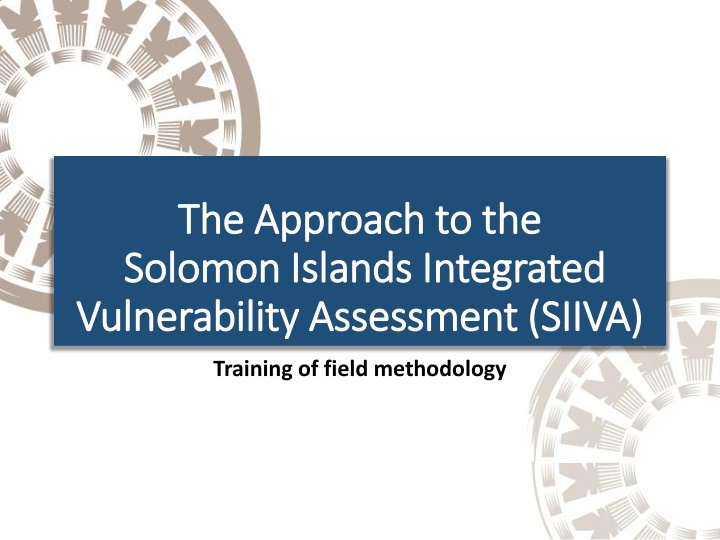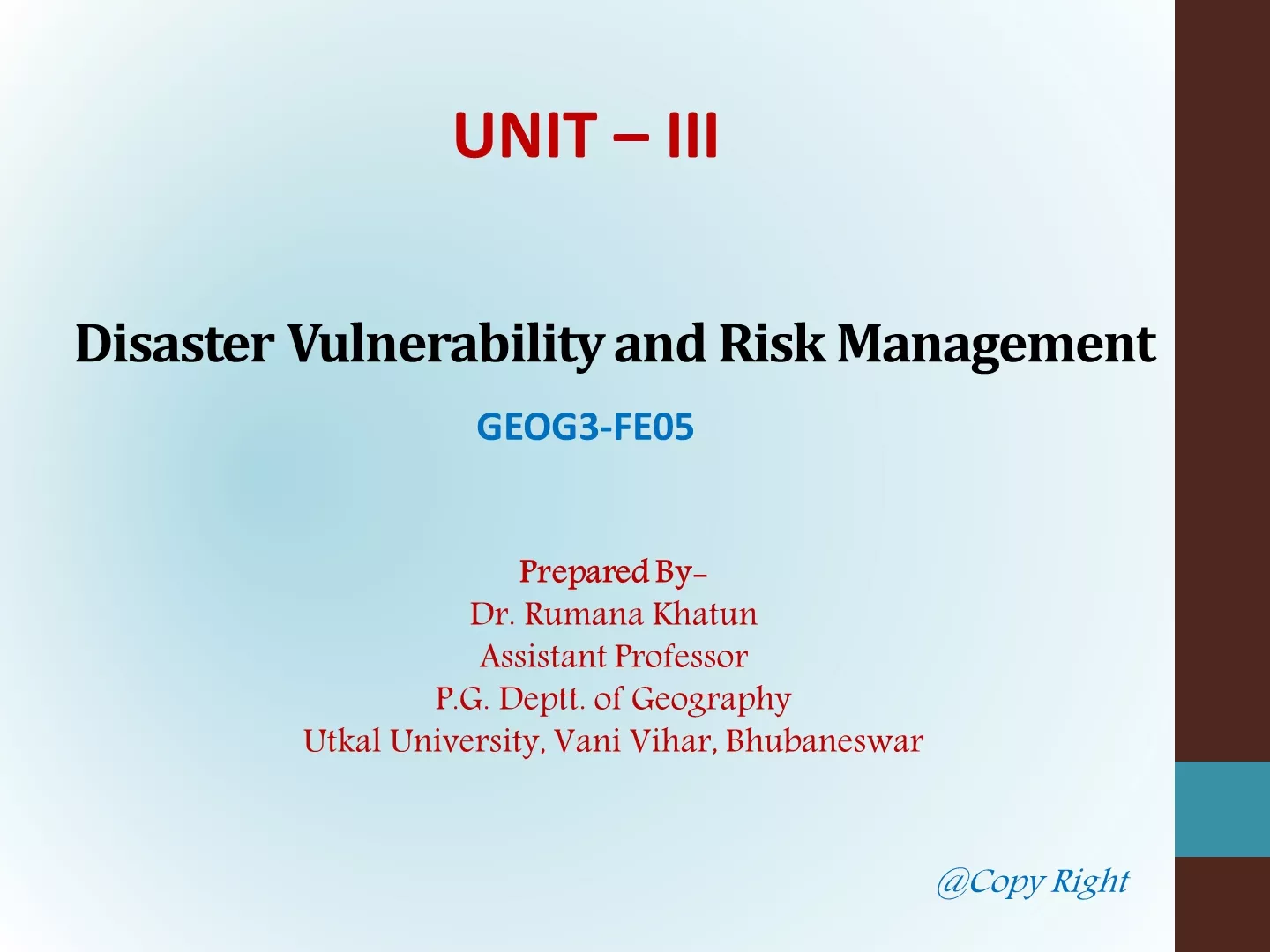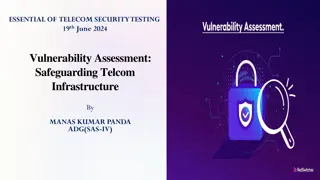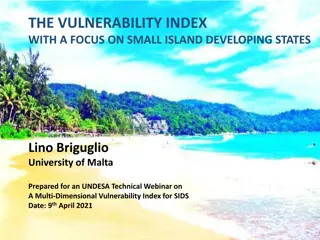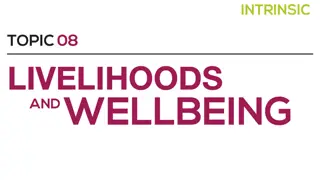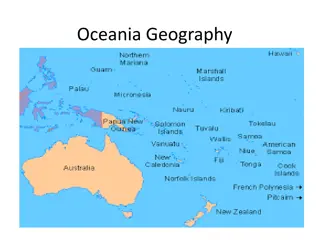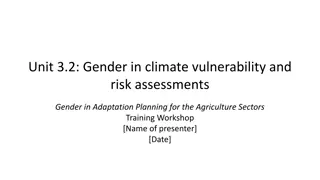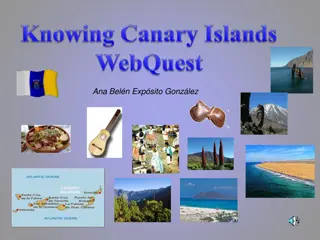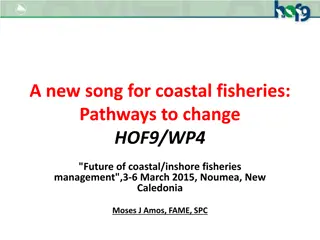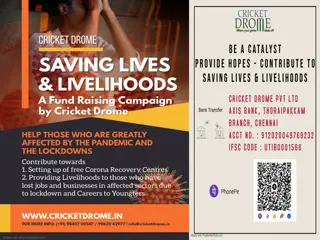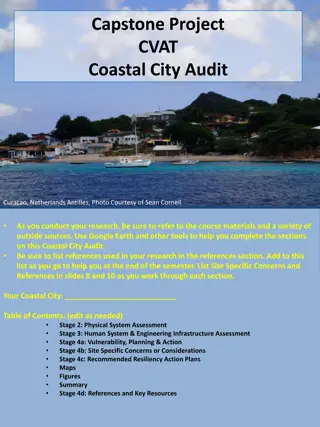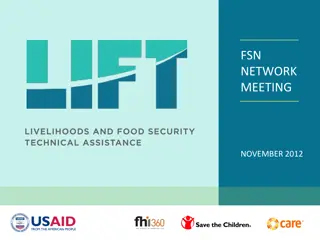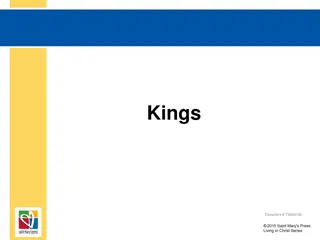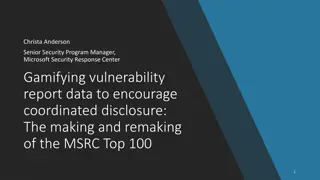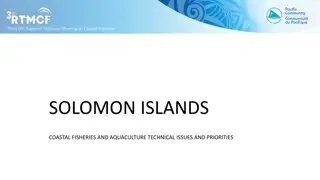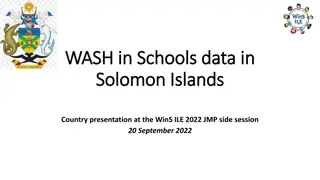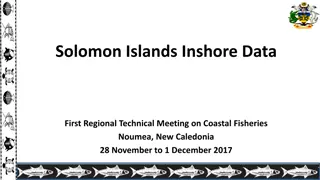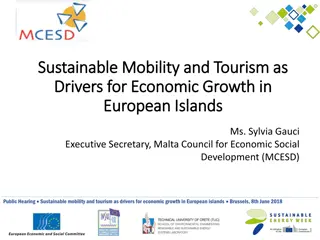Integrated Vulnerability Assessment and Human Security for Sustainable Livelihoods in the Solomon Islands
The approach to the Solomon Islands Integrated Vulnerability Assessment (SIIVA) and the Integrated Vulnerability and Adaptation Assessment (IVA) are key methodologies to assess climate change risks and prepare nations for adaptation. The objectives include informing national climate change policies, enhancing climate finance access, and raising awareness at regional and provincial levels. Human security and sustainable livelihoods are crucial components, emphasizing the protection of human lives and ensuring the capacity to live with dignity, while considering ecosystem health and resilience.
Download Presentation

Please find below an Image/Link to download the presentation.
The content on the website is provided AS IS for your information and personal use only. It may not be sold, licensed, or shared on other websites without obtaining consent from the author.If you encounter any issues during the download, it is possible that the publisher has removed the file from their server.
You are allowed to download the files provided on this website for personal or commercial use, subject to the condition that they are used lawfully. All files are the property of their respective owners.
The content on the website is provided AS IS for your information and personal use only. It may not be sold, licensed, or shared on other websites without obtaining consent from the author.
E N D
Presentation Transcript
The Approach to the The Approach to the Solomon Islands Integrated Solomon Islands Integrated Vulnerability Assessment (SIIVA) Vulnerability Assessment (SIIVA) Training of field methodology
Integrated Vulnerability Assessment (IVA) The Integrated Vulnerability and Adaptation Assessment (IVA a key key instrument instrument to identify and prepare a nation and its people to the risks risks posed posed by by climate climate change adapt to these threats. The IVA recognizes that climate climate change factors factors should be assessed in a multi framework framework. Framework developed by USP PACE-SD. Survey, method and resources by Climate Change Unit. IVA) is change and and disaster disaster, as well as change and multi- -sectral and non sectral vulnerabilities vulnerabilities non- -climate climate change change
IVA Objectives A national vulnerability assessment to comprehensively assess a developing state such as Solomon - (Whole island Approach) Baseline data to inform planning, monitor change and measure impact of adaptation actions to: - Informing National Climate Change Informing National Climate Change Policies (e.g. CC Bill, NAPs, Provincial CC Policies (e.g. CC Bill, NAPs, Provincial CC Frameworks) Frameworks) - Climate finance access Climate finance access - Regional, international meetings Regional, international meetings such as COP such as COP - Provincial level awareness / village Provincial level awareness / village monitoring monitoring Complement additional vulnerability and risk assessment methods
Human security Human security is defined as a condition that exists when the vital core of human lives is protected, and when people have the freedom and capacity to live with dignity . (Adger et al. 2014). Nine Nine broad objectives (HSOs) Forest Health, Watershed Health, Coastal Health, Water Security, Security of place, Energy Security, Income Security, Community Health, Food Security (HSOs) are:
The term livelihood includes the capabilities, assets and activities required for a means of living (DFID, 2000). Livelihood is considered to be sustainable and adaptive when it can adequately deal with climate, disaster and various other shocks whilst maintaining or strengthening its capacity, without undermining the health of natural ecosystems (DFID 2000).
Livelihood Assets Livelihood Assets Ecosystem: Marine and land-based natural resource stocks available to, and effecting, a community Infrastructure: Built structures and equipment available to a community (includes technical extension services provided by government) Financial resources: Money available to a community Human resources: Traditional and modern knowledge and skills of people in a community Institutions and Governance: Informal mechanisms and formal rules that influence how a community interacts, governs, and acts collectively
IVA Vulnerability Issues ECOSYSTEM HEALTH (E) + NATURAL RESOURCES (n) Decline in health of inshore invertebrates (in terms of abundance/size and diversity) Decline in health of inshore fisheries (in terms of abundance/size and diversity) Decline in health of offshore fisheries (in terms of abundance/size and diversity) Decline in coral and reef health Declining/retreating shoreline due to coastal erosion Decline in shoreline vegetation health and cover Decline in mangrove health and cover 9 Sectors 5 Assets Decline in forest cover and health Decline in health of natural island fauna (e.g. coconut crabs/birds/insects/etc.) Decline in bird life and nesting sites (migratory and non-migratory) Presence of marine invasive species (e.g. crown of thorns) Presence of land-based invasive species (e.g. crazy ants/African snails/etc.) Marine pollution (from rubbish and wastewater from toilets and shipping vessels) Land pollution (from rubbish and wastewater) Low resilience of fisheries and coral to past impacts of storms and inundation
IVA FIELD METHODOLOGY IVA FIELD METHODOLOGY
Field methodology Field methodology Formal introduction to the community Formal introduction to the community Formal introduction to the community Transect walk of the community demographics Transect walk of the community & demographics Transect walk of the community & demographics Focus group discussions Focus group discussions Focus group discussions Review of 5 most pressing vulnerabilities Review of 5 most pressing vulnerabilities Review of 5 most pressing vulnerabilities Review of the 3 successful adaptation measures Review of the 3 successful adaptation measures Review of the 3 successful adaptation measures Community risk maps drawn with key and description of risks Community risk maps drawn with key and description of risks Community risk maps drawn with key and description of risks Final transect walk to validate scores Final transect walk to validate scores Final transect walk to validate scores Checklist reviewed by team Checklist reviewed by team Checklist reviewed by team Next Next
1. Formal introduction This includes the ethical briefing which should be clearly delivered to the community following the template that is in the Fulcrum survey This will be the task of the Team leader to deliver this to the community. It is also advisable to have a good representation of women and youths and not just old men to be present All villagers attending the consultation must fill in their details in the attendance record. Back Back
2. Transect walk & demographics The initial transect walk is done so that surveyors have a fair understanding of the community before engaging in the focus group discussions During this transect walk, surveyors can get the quick demographics from the villagers or village elder present Back Back
3. Focus group discussions Each surveyor will be responsible for at-least 2 or 3 sectors. The community members will be spilt into 5 groups of 6 for IVA discussion and each group should have 2 Gents, 2 Female and 2 Youth. After the mixed group discussion the community participants will then later divided into Gents, Female and Youth groups. They will discuss the 5 pressing issues and the 3 adaptation measures that the community have. Next Next
3.1 Details of using Fulcrum during focus group discussions Open fulcrum> You can see that a pilot test folder has been setup for us to use which we will go through after lunch. During the consultation make sure to ask all the questions Any changes is saved when hitting the tick icon on the top right of the survey sheet. First selection of issues in drop down menu; only choose relevant issues that are affecting them severely Then select only the 3 severe vulnerabilities/issues for that question and rank them; #1 is the most pressing one or highest ranking issue. Next Next
Continuation.. Always keep a written copy of the survey should anything happen to your tablet while in the field. Qualitative response must provide clear and understandable detail on the 3 ranked vulnerabilities and should STRICTLY LABELLED Same format must be followed for proposed adaptation options Qualitative responses must reflect the scale of the issue (coastal flooding of 250 metres of foreshore land), where is it taking place(inland 1km N from village, how long has it been noticed (5 years ago), who does it affect, who caused the issue (private industry, village, nature), why hasn t it been fixed etc. Lastly, the scores must reflect the responses provided. Severe vulnerabilities will have a score of 1 while 5 shows that there are no serious issues Remember to save by clicking on the tick icon on the top right at every step of entering data. Back Back
4.Review of 5 most pressing issues Surveyors are to share to the rest of the community the issues that had very low score Community and surveyors will then decide what is the overall 5 most pressing issues Everyone is encouraged to participate and debate on this then come to a common agreement on which are the 5 pressing issues of that community. Back Back
5. Review of 3 successful adaptation measures Repeat procedure for review of 5 most pressing issues Remember to take pictures They may or may not have at-least 3 existing successful adaptations. All that s important, is that you capture what they have in the community in the response as well as in picture form Back Back
6. Risk Maps Satellite images of the villages must be printed and taken to the village on the day of assessment The communities will draw on the printed image the areas where the 5 most pressing issues occur; they may also include other features like the successful adaptation measures Remember to have key and descriptions of the risks when drawing on the map since this will be digitized by another technical specialist. Back Back
7. Final transect walk This walk will be done to verify the responses given and the scores The extent of risks on the map will also be verified when conducting this final transect walk. Pictures of the 5 most pressing issues must be taken then with 3 existing successful adaptation measures. All pictures are to be taken in landscape (horizontally holding the tablet) Back Back
Checklist reviewed Make sure that everything in the checklist is done. The group can delegate one person to check this for them. All photos taken with description, demographics filled, transect walks done and responses entered in the tablet if not, have it all written in the sheets provided. It is important that this is done while at the village to prevent any loss of information. Back Back
TABLET HANDS ON TRAINING TABLET HANDS ON TRAINING
Note Tablet hands-on training details in the SIVA report in the IVA training folder
